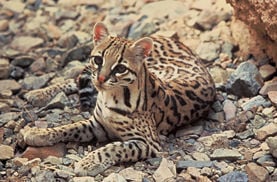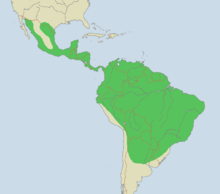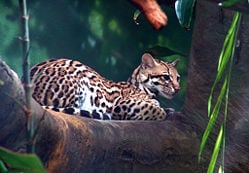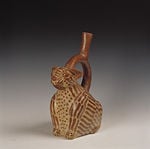Difference between revisions of "Ocelot" - New World Encyclopedia
Rick Swarts (talk | contribs) |
Rick Swarts (talk | contribs) |
||
| Line 80: | Line 80: | ||
* Karttunen, Frances |year=1983 |title=An Analytical Dictionary of Nahuatl |location=Austin |publisher=University of Texas Press |pages=p. 176}} | * Karttunen, Frances |year=1983 |title=An Analytical Dictionary of Nahuatl |location=Austin |publisher=University of Texas Press |pages=p. 176}} | ||
| + | |||
| + | * Langenburg, L., and M. Mulheisen. 2003. [http://animaldiversity.ummz.umich.edu/site/accounts/information/Leopardus_pardalis.html ''Leopardus pardalis'']. ''Animal Diversity Web''. Retrieved May 18, 2008. | ||
*Lockhart, James |year=2001 |title=Nahuatl as Written: Lessons in Older Written Nahuatl, with Copious Examples and Texts |location=Stanford |publisher=Stanford University Press |pages=p. 228}} | *Lockhart, James |year=2001 |title=Nahuatl as Written: Lessons in Older Written Nahuatl, with Copious Examples and Texts |location=Stanford |publisher=Stanford University Press |pages=p. 228}} | ||
Revision as of 21:50, 18 May 2008
| Ocelot[1] | ||||||||||||||
|---|---|---|---|---|---|---|---|---|---|---|---|---|---|---|
 Ocelot
| ||||||||||||||
| Scientific classification | ||||||||||||||
| ||||||||||||||
| Leopardus pardalis (Linnaeus, 1758) | ||||||||||||||
 Ocelot range
|
Ocelot (Leopardus pardalis) is a nocturnal, New World wild cat (family Felidae]], up to about three or four feet in length, and characterized by a grayish to orange yellow fur with black markings and ringed tail. Also known as the painted leopard, McKenney's wildcat or manigordo, the ocelot is distributed over South and Central America and Mexico, but has been reported as far north as Texas and in Trinidad, in the Caribbean.
Fur and was once regarded as particularly valuable. As a result, hundreds of thousands of Ocelots have been killed for their fur. The feline was classified a "vulnerable" endangered species from the 1980s until 1996, but is now generally considered "least concern" by the 2006 IUCN Red List.
Overview and description
The ocelot is part of the Felidae family, which belongs to the Carnivora order within the mammals (Class Mammalia). Members of the family are called cats and sometimes felines. Cats are more strictly carnivorous (meat eating) than most other members of Carnivora (carnivores). The teeth of cats are well suited to their diet, with long canines for gripping prey and blade-like molars for cutting flesh (Voelker 1986).
All cats walk on four feet, in a digitigrade manner—that is on their toes. Their hind legs are longer and stronger than their fore legs, which gives them strength for sprinting and leaping, but not stamina for long distance running. Cats have claws on their feet that are used for gripping prey, for fighting, and for climbing. In the ocelot, as with most cats, the claws can be retracted into the toes, which helps keep them sharp. The bodies of all cats (except some breeds of domestic cat) are covered with thick fur. In most species, this is spotted or striped.
Felidae usually is divided into two subfamilies, Pantherinae (which includes "big cats" like lions, jaguars, tigers, and leopards) and Felinae (which includes the "small cats," although some can be large, like the cougar). The ocelot, placed in species Leopardus pardalis, is part of the Felinae subfamily. The ocelot was formerly listed as Felis pardalis and was first described by Linnaeus in 1758;.
Leopardus pardalis is about 65 to 97 centimeters (26 to 38 inches) in length, not including a 27 to 40 centimeter (11 to 16 inch) tail (Grzimek et al. 2004). It weights between 8.5 and 16 kilograms (18 to 35 pounds) (Grzimek et al. 2004). The ocelot is the largest of the generally dainty Leopardus wild cat genus. While similar in appearance to the oncilla and the margay, which inhabit the same region, the ocelot is larger.
Forest dwelling ocelots tend to have a more yellow or orange-yellow coat, while those living in arid scrub tend to be grayer (Grzimek et al. 2004). There are black markings (spots, rings, an stripes) on the head, neck, body, and tail, with ringed bars on the tail, oval spots arranged in bands on the body, spots on the head, and stripes on the cheeks. The underbelly is white. The ocelot's appearance is similar to that of the domestic cat. Its fur resembles that of a clouded leopard or jaguar.
The name ocelot comes from the Nahuatl word ōcēlōtl (pronounced [oːˈseːloːtɬ]), which usually refers to jaguars (Panthera onca) rather than ocelots (Pickett 2000; Karttunen 1983; Lockhart 2001).
Behavior
The Ocelot is mostly nocturnal and very territorial. It will fight fiercely, sometimes to the death, in territorial disputes. Like most felines, it is solitary, usually meeting only to mate. However, during the day it rests in trees or other dense foliage, and will occasionally share its spot with another Ocelot of the same sex. When mating, the female will find a den in a cave in a rocky bluff, a hollow tree, or a dense (preferably thorny) thicket. The gestation period is estimated to be 70 days. Generally the female will have 2–4 kittens, born in the autumn with their eyes closed and a thin covering of hair.
While the Ocelot is well equipped for an arboreal lifestyle and will sometimes take to the trees, it is mostly terrestrial. Prey includes almost any small animal: monkeys, snakes, rodents, fish, amphibians and birds are common prey, as are small domestic animals such as baby pigs and poultry. Almost all of the prey that the Ocelot hunts is far smaller than itself. Studies suggest that it follows and finds prey via odor trails, but the Ocelot also has very keen vision, including night vision.
Distribution and habitat
The Ocelot is distributed over South and Central America and Mexico, but has been reported as far north as Texas and in Trinidad, in the Caribbean.
The Ocelot once inhabited the chaparral thickets of the Gulf coast in south and eastern Texas, and was found in Arizona. In the United States, it now ranges only in several small areas of dense thicket in South Texas. The Ocelot's continued presence in the U.S. is questionable, due largely to the introduction of dogs, the loss of habitat, and the introduction of highways. Young male Ocelots are frequently killed by cars during their search for a territory. The feline was classified a "vulnerable" endangered species from the 1980s until 1996, but is now generally considered "least concern" by the 2006 IUCN Red List.[2] The Texas Ocelot subspecies, Leopardus pardalis albescens, is still classified as endangered as of the IUCN's 2006 red list.[3]
Subspecies
The following are the currently recognized subspecies:[1]
- Leopardus pardalis pardalis, Amazon Rainforest
- Leopardus pardalis aequatorialis, northern Andes and Central America
- Leopardus pardalis albescens, Mexico, southwestern Texas
- Leopardus pardalis melanurus, Venezuela, Guyana, Trinidad, Barbados, Grenada
- Leopardus pardalis mitis, Argentina, Paraguay
- Leopardus pardalis nelsoni, Mexico
- Leopardus pardalis pseudopardalis, Colombia
- Leopardus pardalis puseaus, Ecuador
- Leopardus pardalis sonoriensis, Mexico
- Leopardus pardalis steinbachi, Bolivia
Other
Like many wild cats, it is occasionally kept as a pet. Salvador Dalí frequently traveled with his pet ocelot, even bringing it aboard the luxury cruise liner SS France.[4][5]
The Moche people of ancient Peru worshipped animals and often depicted ocelots in their art. [6]
Notes
- ↑ 1.0 1.1 W. C. Wozencraft, "Order Carnivora," in D. E. Wilson and D. M. Reeder (eds.), Mammal Species of the World: A Taxonomic and Geographic Reference. (Washington : Smithsonian Institution Press, 1993). ISBN 1560982179.
- ↑ 2.0 2.1 Cat Specialist Group 2002. [1]. 2006 IUCN Red List of Threatened Species., World Conservation Union. Retrieved on 12 May 2006. Database entry includes justification for why this species is of least concern
- ↑ Cat Specialist Group 2002. [2]. 2006 IUCN Red List of Threatened Species., World Conservation Union. Retrieved on 12 May 2006. Database entry includes justification for why this species is endangered
- ↑ Photo of silver optical piece with hand-cut collage of Dali, including picture of him with his Ocelot.
- ↑ Huggler, Justin; "Chic ship too toxic for scrapping" from ssmaritime.com
- ↑ Berrin, Katherine & Larco Museum. The Spirit of Ancient Peru:Treasures from the Museo Arqueológico Rafael Larco Herrera. New York: Thames and Hudson, 1997.
ReferencesISBN links support NWE through referral fees
- Grzimek, B., D. G. Kleiman, V. Geist, and M. C. McDade. 2004. Grzimek's Animal Life Encyclopedia. Detroit: Thomson-Gale. ISBN 0787657883.
- Pickett, Joseph P. et al. (eds.) |year=2000 |chapter=ocelot |title=The American Heritage Dictionary of the English Language |edition=4th ed. |location=Boston |publisher=Houghton Mifflin}}
- Karttunen, Frances |year=1983 |title=An Analytical Dictionary of Nahuatl |location=Austin |publisher=University of Texas Press |pages=p. 176}}
- Langenburg, L., and M. Mulheisen. 2003. Leopardus pardalis. Animal Diversity Web. Retrieved May 18, 2008.
- Lockhart, James |year=2001 |title=Nahuatl as Written: Lessons in Older Written Nahuatl, with Copious Examples and Texts |location=Stanford |publisher=Stanford University Press |pages=p. 228}}
- Voelker, W. 1986. The Natural History of Living Mammals. Medford, New Jersey: Plexus Publishing. ISBN 0937548081.
External links
Credits
New World Encyclopedia writers and editors rewrote and completed the Wikipedia article in accordance with New World Encyclopedia standards. This article abides by terms of the Creative Commons CC-by-sa 3.0 License (CC-by-sa), which may be used and disseminated with proper attribution. Credit is due under the terms of this license that can reference both the New World Encyclopedia contributors and the selfless volunteer contributors of the Wikimedia Foundation. To cite this article click here for a list of acceptable citing formats.The history of earlier contributions by wikipedians is accessible to researchers here:
The history of this article since it was imported to New World Encyclopedia:
Note: Some restrictions may apply to use of individual images which are separately licensed.




